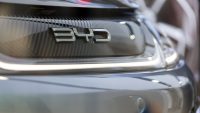Last month saw the UK’s new market fall for just the second time this year with registrations down by 6%, according to new data from the SMMT.
Figures released by the trade body this morning (Nov 5) show that there were 144,288 new registrations in the tenth month of the year, compared to 153,529 in the same month of 2023.
The result was also well below the 275,239 units registered in September – although those figures were significantly boosted by the month’s traditional new plate day.
The slump was seen across all buyer types, with fleets down 1.7% and the the low-volume business market declining 12.8%.
Meanwhile, private purchases fell by 11.8% – continuing a downward trend which has lasted for two years – meaning that fewer than four in 10 (38.8%) of new cars registered in the first 10 months have gone directly to private buyers.
The fall was driven by double-digit drops in petrol and diesel vehicle deliveries, down 14.2% and 20.5% respectively. When it came to hybrids, HEVs fell by 1.6% and PHEVs by 3.2%.
There was some good news for EVs though, with BEVs the only powertrain to record growth. Analysts from the SMMT found that the market was boosted by a swathe of new models, leading to a 24.5% rise in new registrations. The powertrain also reached a 20.7% market share last month.
Research found that UK new car buyers now have more than 125 different BEV models to choose from – an uplift of 38% over the last 10 months.
And while price does remain a major barrier to entry into the new EV market, experts found that, thanks to widening choice and huge manufacturer discounting, around one in five BEV models now has a lower purchase price than the average petrol or diesel car.
In the year-to-date, almost 300,000 new BEVs have reached the road in 2024, representing 18.1% of the market – an increase on 2023, but still significantly short of the 22% target for this year and of the 28% which must be achieved in 2025 under the Vehicle Emissions Trading Scheme.
In response to the results, Mike Hawes, SMMT chief executive, said, ‘Massive manufacturer investment in model choice and market support is helping make the UK the second largest EV market in Europe.
‘That transition, however, must not perversely slow down the reduction of carbon emissions from road transport.
‘Fleet renewal across the market remains the quickest way to decarbonise, so diminishing overall uptake is not good news for the economy, for investment or for the environment.
‘EVs already work for many people and businesses, but to shift the entire market at the pace demanded requires significant intervention on incentives, infrastructure and regulation.’
Meanwhile, when it came to the month’s best-selling new cars, the list was topped by the Kia Sportage on 4,533 units.
The result means that the South Korean model has now sold 42,115 units so far this year, making it the second most popular car behind the Ford Puma on 42,465.
The Puma itself was second in October on 3,521 units, with the likes of the Mini Cooper (2,921), Volvo XC40 (2,675) and Volkswagen Tiguan (2,477) also proving popular.
How has the industry reacted?
‘We urgently need to make the positive case for EVs’
‘October new car sales are lagging, although electric vehicles are taking a bigger share of the market thanks to heavy discounting.
‘The subdued petrol and diesel sales are also likely to be driven by the efforts of manufacturers to hit EV sales targets under the Zero Emissions Vehicles mandate.
‘Manufacturers are making significant efforts to bridge the price gap to electric – as shown by the average 12% electric discount on Auto Trader’s site in October – but the market is still not achieving the volumes needed.
‘With the reinstated 2030 ban date on the sale of new petrol and diesels vehicles looming, we urgently need to make the positive case for EVs to ensure a broader healthy new car market.’
Ian Plummer, commercial director Auto Trader
‘Fuel duty freeze will ease pressure on consumers’ wallets’
‘Following the recent Budget, there will be hope that the fuel duty freeze will ease pressure on consumers’ wallets and stimulate demand.
‘Many will be looking to see if announcements, such as the continuation of company car tax incentives until 2028 and the differentials in Vehicle Excise Duty, will have any impact on the demand for electric vehicles.
‘These announcements, coupled with the promised investment in both manufacturing and infrastructure such as charging points, will have a key role to play in making the 2030 ban on new petrol and diesel vehicles realistic.’
John Cassidy, managing director of sales at Close Brothers Motor Finance
‘Increasingly likely that the UK will fall short of the ZEV mandate’
‘Heavy discounting and a more competitive market have ignited demand for BEVs. In October, demand accelerated by 24.5%, offering hope that progress is being made on the road to net zero.
‘However, the sector is still facing challenges. There may have been a double-digit drop in petrol and diesel vehicle deliveries, but the reality is that it’s not enough to drive real change with 56.6% of buyers in October still opting for diesel or petrol alternatives.
‘And fleet uptake has been the big driver behind new BEV registrations, while demand among private buyers has been much lower.
‘It’s also looking increasingly likely that the UK will fall short of the ambitious zero-emissions vehicle mandate of 22% by the end of the year.
‘Fiscal incentives, such as this week’s decision to increase the differential between fully electric and other vehicles in the first rates of Vehicle Excise Duty, may help slightly.
‘But to avoid momentum stalling, the industry needs more investment. Efforts to increase the availability and distribution of charging points need to be continued.
‘It’s also important that there is a plan in place to manage the growing amount of charging infrastructure. Robust systems that simplify the way charging stations are accessed, maintained and monetised are needed to ensure a seamless EV experience.’
Russell Olive, UK director, Vaylens
‘EVs are accelerating onto our roads at record speed’
‘The discourse surrounding EV demand has intensified over the past year, yet one thing is unmistakable: EVs are accelerating onto our roads at record speed.
‘There are more EVs than ever on our roads with over 300,000 new EVs in 2024 alone, and that number will continue to surge in the near future.
We’re seeing heightened demand for EV charging points across our estate and forecast that rising over the coming months and years ahead.
‘It’s incredibly important that we ensure EV demand is energised and to do that we can’t just rely on tax incentives. EVs need to drive demand on their own merit.
‘To get there, we must tackle range anxiety and continue expanding charging infrastructure.’
Sajid Yacoob, EV and renewables director at leading motorway services operator, Roadchef
‘New car market faces an important end to the year’
‘The new car market experienced another bump in the road in October, as sales slumped for the second time in three months.
‘The arrival of new ‘74 plates provided a shot in the arm in September as the market returned to growth following August’s downturn.
‘However, the recovery was short lived as it wasn’t enough to sustain growth in new car sales last month. The market’s stability remains fragile, impacted by broader economic headwinds that have dampened private buyer demand and resulted in a 11.8% decline in sales.
‘Previously fleet purchases had been propping up the market, but sales were also down in October.
‘Despite the overall slowdown, we continue to see a notable increase in electric vehicle (EV) registrations — rising by 24.5% in October — that has pushed EV market share to 20.7%.
‘This follows last week’s Autumn Budget, where the Chancellor reaffirmed Labour’s commitment to EVs by announcing initiatives to stimulate demand.
‘The proposals include extending low company car tax, improving charging infrastructure, and changing Vehicle Excise Duty (VED) first-year rates from April 2025 to make electric vehicles more financially attractive to consumers and businesses.
‘While there is broad consumer support for going electric, some drivers have been discouraged by pricing levels and concerns over a lack of public charging points.
‘The second-hand EV market is a more attractive and affordable option for most prospective buyers, as an influx of nearly-new cars is enhancing the range of choice and pricing options.
‘Our data shows that the price of the most popular second-hand EVs and hybrids on AA Cars’ fell by 16% in Q3 this year.
‘The new car market faces an important end to the year as it hopes for a return to growth and a stronger footing for the start of 2025.’
James Hosking, managing director of AA Cars
‘Purses are being tightened’
‘Sales were subdued in October as new car registrations fell by 6.0% which can likely be attributed to the current financial strains faced by consumers.
‘However, it is encouraging to see market share of battery electric vehicles increasing, but more needs to be done to meet the zero-emission vehicle target of 22% for 2024.
‘The government’s decision in last week’s Budget to maintain incentives, such as the Benefit-in-Kind tax rate to boost electric vehicle purchases, provides some relief for the industry. However, some businesses will be hoping for further support to help accelerate sales.
‘Based on our calculations, from April 2025 when the new rate of national insurance comes in, a company with a fleet of 100 electric vehicles will expect to see savings of £564,000, compared to a company with a fleet of 100 internal combustion engine vehicles.
‘As the commitment to phase out cars that rely solely on petrol and diesel engines by 2030 was confirmed in the Budget, measures to provide further investments in charging infrastructure, especially in those areas where access remains limited, will provide some impetus to drivers who still remain on the fence about switching to electric.
‘As we head towards Christmas, it’s worth noting that consumer finances will likely come under further strain.
‘While drivers will be relieved that fuel duty has been frozen for another year, we are hearing from some manufacturers that the number of drivers bringing their cars in for minor repairs has dropped.
‘People are also increasingly waiting until something goes wrong with their vehicles before spending any money on their cars – a sign that purses are being tightened.’


































